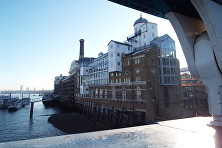
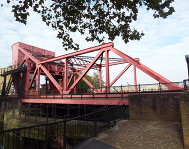
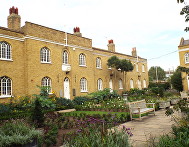
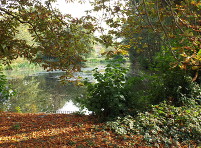
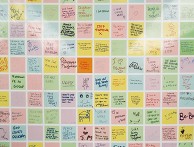

Exploring Southwark and discovering its history


Courage Brewery
There were two great breweries in North Southwark known as the Anchor Brewery, the Barclay Perkins brewery in Bankside and the Courage Brewery on the south side of Tower Bridge. The two companies merged in 1955 and both taken over in the early 1970s by the Imperial Tobacco Group. Both breweries were closed in 1981. The former Barclay Perkins site was demolished to make way for housing but part of the Courage Brewery remains on the riverfront, a reminder of Bermondsey’s great industrial past.
The Courage Brewery was founded in 1787 by John Courage who had left his native Aberdeen in 1780 to come to London. He was employed as an agent for Carron Ships until he purchased an existing brewhouse for £615.13.11, located in the Horsleydown area of Bermondsey. In medieval times, Horsleydown had been a large field where horses where pastured and sold. Some say the name Horsleydown derives from ‘hill by the horse marsh’, others that it derives from horses resting, as in ‘horse lie down.’ John Courage named his newly acquired brewhouse the Anchor Brewery but, sad to say, he was not able to personally build up his business as he died suddenly in 1793 at the young age of 32.
He left a widow Harriet, who continued the business until she too died in 1797. The marriage had produced 3 daughters and one son, also called John and three years old when his father died. Care of the children and the business fell to the managing clerk, John Donaldson, who became a partner receiving one third of the profits that later rose to a half. John the second began work at the Courage and Donaldson Brewery as it was now known when aged 14 in 1804 and became a full partner when he reached the age of 21. He married Susan, the daughter of a brewer, and they lived in De Crespigny Terrace in Camberwell, which was then considered the countryside.
John Courage the Second and John Donaldson developed the brewery into a thriving business and later Donaldson’s sons were admitted as partners. In 1851 the company reverted in whole to the Courage family and two of John the Second’s sons entered the company as partners, and after their father’s death in 1854, a third son became a partner.
When the first John Courage purchased the brewhouse it consisted only of a small building and foreshore but he and his son quickly acquired and absorbed surrounding sites into the brewery. Beer produced by Courage grew in reputation and orders were delivered by sea and river transport to Lowestoft, Dundee and continental ports including Hamburg. A well was sunk in the brewhouse which produced 200 barrels of water an hour from the River Thames. The water produced high quality mild ale and stout but lacked the minerals necessary to produce pale ale so Courage entered into an agreement in 1872 with Flower and Son of Stratford on Avon to supply them with pale ale. The contract later passed to Fremlins in Maidstone but in 1903, Courage acquired their own brewery in Alton, Hampshire for the brewing of pale ale.
In 1886 construction of Tower Bridge commenced and Courage had to relinquish some of their land, including a warehouse, wharf and office, to accommodate the building of the approach road to the bridge from the south. Disaster struck in 1891 when a spark in the malt mills caused an explosion and started a fire that raged for several days. The fire destroyed the brewhouse which was rebuilt to the most modern standards. The waterside premises had deep concrete foundations that were sunk well below the bed of the river and included a new malt tower and chimney shaft and further enhancements were made in the rebuilding. By this time, the brewery, which now had an annual output of 300,000 barrels, had become a public company, having floated on the stock market in 1889. The family still dominated the business with Robert, Edward and Henry Courage appointed as Directors and Robert appointed as the company’s first Chairman. Robert was succeeded by his brother Edward upon his death in 1893. The next generation of the Courage family became involved in the company and it was not until the merger with neighbouring brewers Barclay Perkins in 1955 to form Courage & Barclay Ltd that the Courage family control of the company was weakened. It was Richard Courage who was Chairman in 1972 when the Imperial Tobacco Group acquired the company.
GH Hardinge describes the buildings and operation of the brewery in 1932 in his book The Development and Growth of Courage’s. The Brewery had a river frontage of 185 feet that extended to Gainsford Street and covered an area of four acres. The property was divided by Shad Thames and bounded on the west by Horselydown Lane. The brewing took place in the riverside premises with plant and machinery consisting of 4 oil burning boilers, 6 steel malt bins, 3 mash tuns, 2 coppers and 9 storage tanks for oil which were able to contain enough oil to last for 6 weeks. The beer was then pumped across in pipes to the south side of Shad Thames into a pure air refrigerator room where it ran into one of 31 different sized copper lined fermenting vessels that combined to give a total capacity of 11,000 barrels. After fermentation, the beer was chilled and carbonated and then stored until required when it was pumped through filters into casks by air pressure.
In addition to the fermenting rooms, the buildings on the south side of Shad Thames consisted of a power house, which contained two ice making machines; cold storage for 3,000 pockets of hops; racking floors; tank cellars; cask floors; and a loading-yard, with steam cooperage and washing floor above. On the ground floor were the offices for the directors and other staff and on the first floor an oak-lined boardroom and surveyor’s office. The stables, garages and carpenters’ shops were situated in Queen Elizabeth Street.
“When the [public] company started in 1889 horses were still the means of transport, and the stud consisted of 78 animals; by 1914 the number heavy draught horses had increased to 104. The Courages have always been lovers of the horse, and they held a great name for possessing the best horses on the road. The teams were arranged in colour, and it was a grand sight to see a unicorn of three pulling about six tons of beer through the crowded streets of London. Mr Henry Courage devoted himself to this Department and he was succeeded by his son, the late Mr H Ernest Courage" (Hardinge)
The great Courage dray horses are commemorated by this statue 'Jacob' in Queen Elizabeth Street where the stables had been situated.
Courage still had 14 working horses delivering beer around London in 1951 but it was decided that these horse drawn wagons were not commercially viable. The great horses were pensioned off and moved to stables next to the Alton brewery where they were used for publicity purposes and a team of six horses and maroon and gold dray were maintained.
The Imperial Tobacco Group who had taken over Courage in 1972 was itself taken over in 1986. Since that time there were more changes of ownership of the Courage brand, a sequence can be found on the Wikipedia page.
After the Courage Brewery at Horsleydown was closed in 1981, the riverside frontage was retained while most of the brewery buildings to the rear were demolished. The riverside buildings were restored as far as possible to their original appearance and the chimney retained. The central section had been badly damaged by bombs during World War II and it was replaced by a modern steel and glass section, together with the projecting wooden boxes which originally allowed materials to be winched up from the barges in the river below. Additionally a large vertical glass bay was added to the original west elevation overlooking Tower Bridge. Anchor Brewhouse now consists of 62 apartments, including studios, maisonettes, one- and two-bedroom apartments and a large penthouse on three floors, including the whole ninth floor. A new development, Tower Bridge Piazza, was constructed on the cleared area to the south of Shad Thames.
Web discoveries
- UK Casino Not On Gamstop
- UK Casino Not On Gamstop
- Non Gamstop Casino
- Casinos Not On Gamstop
- Non Gamstop Casinos
- Non Gamstop Casinos
- Non Gamstop Casino
- Casinos Not On Gamstop
- Casino Sites Not On Gamstop
- Slots Not On Gamstop
- Casinos Not On Gamstop
- UK Betting Sites Not On Gamstop
- UK Casino Not On Gamstop
- Best Non Gamstop Casinos
- Betting Sites
- Non Gamstop Casino Sites UK
- Best Non Gamstop Casinos
- Non Gamstop Casino
- Casinos Not On Gamstop
- Non Gamstop Casino Sites UK
- Horse Racing Betting